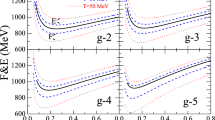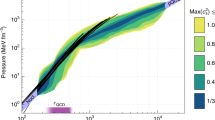Abstract
It is expected that at very large densities and/or temperatures a quark-hadron phase transition takes place. Lattice QCD calculations at zero baryon density indicate that the transition occurs at T c ∼ 150–170 MeV. The transition is likely to be second order or a cross over phenomenon. Although not much is known about the density at which the phase transition takes place at small temperatures, it is expected to occur around the nuclear densities of few times nuclear matter density. Also, there is a strong reason to believe that the quark matter formed after the phase transition is in colour superconducting phase. The matter densities in the interior of neutron stars being larger than the nuclear matter density, the neutron star cores may possibly consist of quark matter which may be formed during the collapse of supernova. Starting with the assumption that the quark matter, when formed consists of predominantly u and d quarks, we consider the evolution of s quarks by weak interactions in the present work. The reaction rates and time required to reach the chemical equilibrium are computed here. Our calculations show that the chemical equilibrium is reached in about 10−7 seconds. Further more during the equilibration process enormous amont of energy is released and copious numbers of neutrinos are produced. Implications of these on the evolution of supernovae will be discussed.
Similar content being viewed by others
References
F Karsch, hep-lat/9909006
B Muller, The physics of the quark-gluon plasma (Springer, Berlin, 1985)
The energy density of normal nuclear matter is about 0.17 × 938 ∼ 150 MeV/fm3. If we ignore the interaction energy, at four times nuclear matter density the energy density would be ∼600 MeV/fm3, which is the transition energy density indicated by the lattice-QCD calculations.
M Alford, K Rajagopal and F Wilczek, Nucl. Phys. B537, 443 (1999)
J M Lattimer and M Prakash, astro-ph/0002232
Actually the strangeness fraction could be nonzero in the hadronic phase. That is because the baryonic matter may have strange baryons or may have kaon condensate. The calculations based on Walecka model [5] show that one may have a strangeness fraction of 0.2 at 3–5 × ρ NM. Similarly, kaon condensate [6], if formed, may generate strangeness fraction of similar order.
In fact, we treat it as an initial condition and perform the computation for a set of values of p B . Extrapolation of lattice QCD results implies that the transition would be occurring at ρ B of 3–5 times ρ NM.
Sanjay K Ghosh, S C Phatak and Pradip K Sahu, Z. Phys. A352, 457 (1995)
V Thorson, M Prakash and J M Lattimer, Nucl. Phys. A572, 693 (1994)
E D Commins and Bucksbaum, Weak interactions of leptons and quarks (Cambridge University Press, Cambridge, 1983)
A Chodos, R L Jaffe, K Johnson, C B Thorn and V F Weisskopf, Phys. Rev. D30, 2379 (1989)
S Sahu and S C Phatak, Mod. Phys. Lett. A7, 709 (1992)
M Prakash, J M Lattimer, J A Pons, A W Steiner and S Reddy, astro-ph/0012136
A Burrows, Ann. Rev. Nucl. Sci. 40, 181 (1990)
U Heinz and M Jacob, nucl-th/0002042
J N Bahcall, Neutrino astrophysics (Cambridge University Press, Cambridge, 1989)
Neutrino transport in neutron stars is still an open subject. However it is estimated [13] that the neutrinos produced in nuclear interactions (which are having energies between 10 and 100 MeV) degrade their energy and generate a number of secondary neutrinos of all species during propagation through the matter. It is estimated that the number of neutrinos are increased by a factor of 10. The neutrinos produced in quark matter have even higher energies so it would be reasonable to expect that here the increase could be by a factor of 10 or more.
Author information
Authors and Affiliations
Rights and permissions
About this article
Cite this article
Phatak, S.C. Quark matter formation in dense stellar objects. Pramana - J Phys 57, 325–335 (2001). https://doi.org/10.1007/s12043-001-0042-8
Issue Date:
DOI: https://doi.org/10.1007/s12043-001-0042-8




